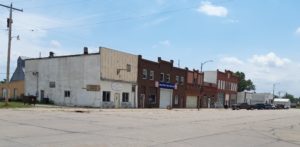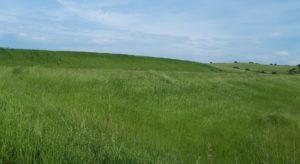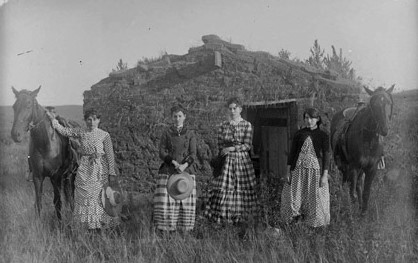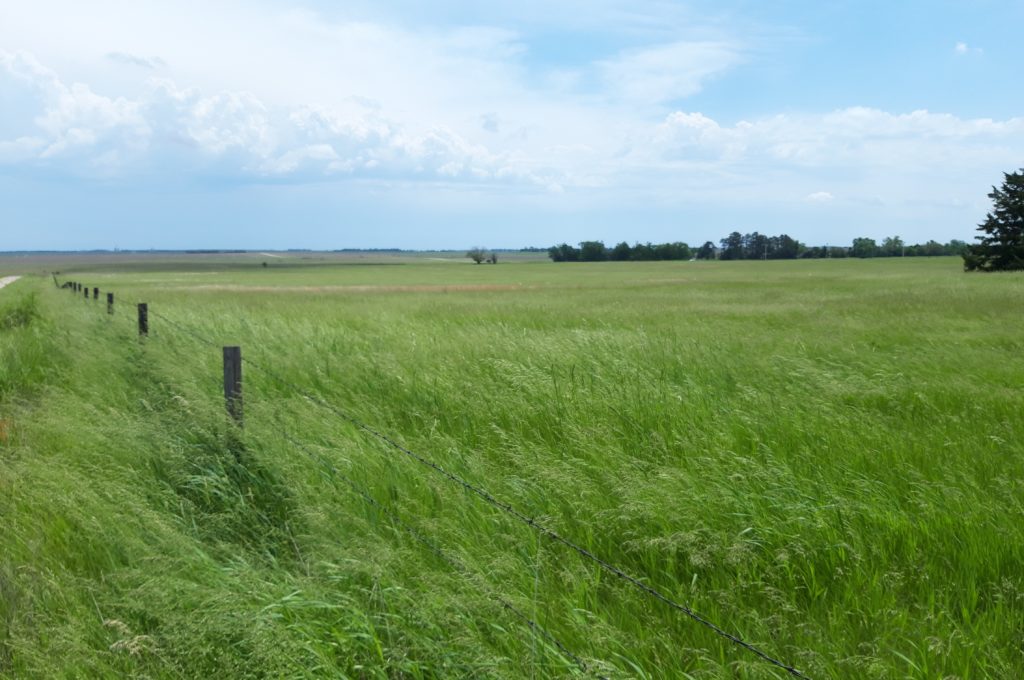
Main St. in the village of Long Pine. Photo clearly shows how small the place is. A drive throughout the rural surrounding areas shows a farm here and there, evidence of small population in the county. Photo JÞ

A typical farmland in Brown County. Grass covered rolling hills which are quite sandy. Photo JÞ
Brown County is in northern Nebraska, close to the South Dakota state line. The country lies quite high compared to other counties to the east and south. Long Pine, the main village in this vast cattle ranching area, is at 2,402 feet above sea level, while the state capital, Lincoln, is only 1,176 feet high. All the land in the northern part of the state rises and continues to rise into the southernmost settlements in S. Dakota; it is a relatively short distance to the Black Hills. The land around Long Pine is rugged, grassy and an ideal pasture for cattle. Although cornfields can be found here and there, agriculture is all about cattle. Perhaps this was one of the main reasons for Icelanders’ interest in this area. Many had tried farming in the eastern part of the state, in Lancaster County, where almost exclusively crop farming is practiced. Most disappeared from there and settled in Brown County. Sigfús Magnússon had explored lands with Jón Halldórsson in the eastern part of Nebraska in 1874. They both homesteaded but later gave up their lands; Sigfús primarily because he returned to Iceland the same year with Torfi Bjarnason. Sigfús then returned with his wife and children in 1886 and describes his return as follows:

The picture shows a typical “mud hut” (sod house) during the settlement years in Nebraska. Residents unknown. NHS image.
“We finally arrived in Long Pine, Nebraska on August 6, after almost a month of such a tiring trip. In Long Pine (a very small village) I immediately met my old friend and playmate, Jón Halldórsson because I had decided, before I left Iceland, to settle near him and other people I knew there. I knew little or nothing about land quality. The first winter I stayed with Jón Kristjánsson, Jón’s half-brother, who is mentioned before. In the autumn I took out the right to 160 acres of government land, and another 160 acres, which I got on two conditions to plant 10 acres of trees on it. At the same time, I also received my first citizenship letter. (Renounced Icelandic citizenship and became a citizen of the United States: insert JÞ) In the spring of 1887 I moved to my land, after I had built a house out of the earth; it was sheltered and not very hot in summer. In this mud hut I lived for 5 years, made all the improvements in the lands that the law required, but because the soil was not good, hilly and sandy, and there was a long way for the children to go to school, which was also poorly taught, I saw that this could not be my future home, so I decided to move to Minnesota, because I also had full rights to the country and could go wherever I wanted “.
It is worth pausing here because much of Sigfús’ story is remarkable. First, it is remarkable how much land he takes. Each settler in North America was entitled to 160 acres, but Sigfús commits to another 160 acres. This is not an outrageous man, but shows foresight, he obviously considered raising cattle, but such farming required a lot of land. For comparison, the Icelanders who fled from New Iceland south to N. Dakota were content with 40, 60, or 80 acres. And the brothers Lárus and Aðalbjartur Bjarnason took 80 acres each of good arable land east in Lancaster and Gage counties. Nebraska, like so many other states, offered settlers so-called forestry rights. The settlers undertook to plant a certain number of trees in parts of the country during a certain period. This right was widely used, e.g., in N. Dakota and southern Minnesota. Building materials were in short supply, which can be seen in the fact that Sigfús builds a “mud hut” from turf. He states that he has lived in this hut for five years and completed all the improvements that were required, e.g., planting of trees. But as stated above, the soil is hilly and sandy. Undoubtedly, Sigfús has intended to cultivate something but has not succeeded, so he leaves.
English version by Thor Group

This photo shows the rural area south of Long Pine. A farmer planted trees to shelter his home and other buildings in the center. Photo JÞ
